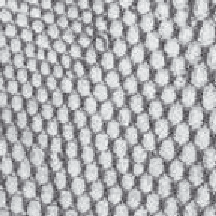Image Processing Reference
In-Depth Information
and (c) would lead back to the original signal. This can be seen in computer images as
illustrated in Figure
2.8
which show a texture image (a chain-link fence) taken at different
spatial resolutions. The lines in an original version are replaced by indistinct information
in the version sampled at low frequency. Indeed, it would be difficult to imagine what
Figure
2.8
(c) represents, whereas it is much more clear in Figures
2.8
(a) and (b). Also, the
texture in Figure
2.8
(a) appears to have underlying distortion (the fence appears to be bent)
whereas Figures
2.8
(b) and (c) do not show this. This is the result of sampling at too low
a frequency. If we sample at high frequency, the interpolated result matches the original
signal. If we sample at too low a frequency we get the wrong signal.
(a) Original image
(b) Medium resolution
(c) Low resolution - aliased
Figure 2.8
Aliasing in sampled imagery
Obtaining the wrong signal is called
aliasing
: our interpolated signal is an alias of its
proper form. Clearly, we want to
avoid
aliasing, so according to the sampling theorem we
must sample at twice the maximum frequency of the signal coming out of the camera. The
maximum frequency is defined to be 5.5 MHz so we must sample the camera signal at
11 MHz. (For information, when using a computer to analyse speech we must sample the
speech at a minimum frequency of 12 kHz since the maximum speech frequency is 6 kHz.)
Given the timing of a video signal, sampling at 11 MHz implies a minimum image resolution
of 576
576 pixels. This is unfortunate: 576 is not an integer power of two which has poor
implications for storage and processing. Accordingly, since many image processing systems
have a maximum resolution of 512
512, they must anticipate aliasing. This is mitigated
somewhat by the observations that:
1.
globally, the
lower
frequencies carry
more
information whereas
locally
the
higher
frequencies contain more information so the corruption of high frequency information
is of less importance; and
2.
there is
limited
depth of focus in imaging systems (reducing high frequency content).
But aliasing can, and does, occur and we must remember this when interpreting images.
A different form of this argument applies to the images derived from digital cameras. The
basic argument that the precision of the estimates of the high order frequency components
is dictated by the relationship between the effective sampling frequency (the number of
image points) and the imaged structure, naturally still applies.



















